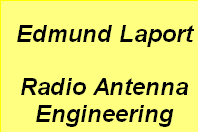

Antentop is FREE e-magazine devoted to Antennas and Amateur Radio an
Special page devoted to
Long
Delay Echoes

Custom Search
|
ANTENTOP-
01- 2007, # 009 |
Long
Delay Echoes |
|
|
|
||
|
It was our signal, same speed, same automatic
keying characteristics, same everything. We had a tape
of it for a long time, and I had a copy of the tape, but at some
point, years ago, I lost it or erased it. Ed
wrote an interesting article on LDE that is at his website
: http://w5htw.home.att.net/index.html. With Ed's kindly permission the article
is printed below. ------------------------------------------------------------------ LDES - LONG DELAYED ECHOS There are stories told in the cult books
of radio signals being heard again years after the radio station
left the air. One such story involved a broadcast AM station
that had closed down, yet the radio signal was heard nearly two
years after the station went off the air. Those stories are like the UFO and ghost
stories. They have no foundation. LDEs, though, are very real. What
they are not, are attempts by some alien space craft to contact
us. What they are is an as-yet unexplained electromagnetic phenomena relating
to radio waves. In the 1960s There are some facts available about
the standard LDE. First, it does not show signs of Doppler
shift. It is on frequency, it remains on frequency for the
duration, and the pitch, if it is CW, remains steady. Secondly, it is rarely a full transmission.
It is segments, often very short segments, only five or six seconds,
of a transmission. It may not begin at the beginning,
and it may not end at the ending of the original transmission.
It is not complete. Third it does
not fade in or fade out. It is "there."
At least that is true of the one I heard that was so clearly identifiable.
It turns on, and then it turns
off. |
Fourth, they have been showing up LONG before computer
sound cards. While it is possible one or two could be a
hoax, it is highly unlikely. Fifth, they are not limited to the ham bands. Sixth, reports of them are mostly in the 3 to 18 mhz range. Occasionally one is heard above that, and
on very rare occasions, one below that. This could
be because most radio activity
is in that range, so it really isn't a defining fact, but it is
a point to consider. MY OWN EXPERIENCE To my knowledge I have heard only one LDE. It
is possible I have heard others, but did not recognize them as
such, perhaps due to crowded band conditions, or other situations.
The one I heard, though, was unmistakable. To explain it,
I have to set the scene a bit. This was in 1967, in the
I was a government radio operator/tech at a somewhat
isolated radio relay site. We ran a CW net that was used almost
entirely for the purpose of establishing contact and setup procedures
for RTTY operations. Hence it carried very little, and very
intermittent, CW traffic. We ran three or four transmitters
simultaneously, depending upon time of day. We ran four
receivers (Collins 51J3/R388) models in a console. There was a
J38 straight key for our use. There was also a Frederick
Electronics Baudot to Morse converter, that converted 5-level punched paper (or plastic)
TTY tape to Morse. We ran what is typically know
as a "guard" frequency. You've heard them on the
marine bands. It sends something like: VVV VVV
Our machine sent this (and this is a fictitious call
sign, not the one we used) VVV VVV VVV DE AAA123 AAA123 AAA123 VVV VVV VVV DE AAA123 AAA123 AAA123 VVV VVV VVV DE AAA123 AAA123 AAA123 QSX 4/6/10 K (In the day time the freqs would change to 6/10/13) That sequence,
at 18 wpm, took just about one full minute. The tape then
looped (using "letters" characters) for another full
minute, during which time any station could call in. |
|
|
|
||
|
Page 65 |
||
 |
 |
 |
 |
Just for Fun:

Powered byIP2Location.com
Thanks for your time!
Last Updated:
February 6, 2020 22:03





